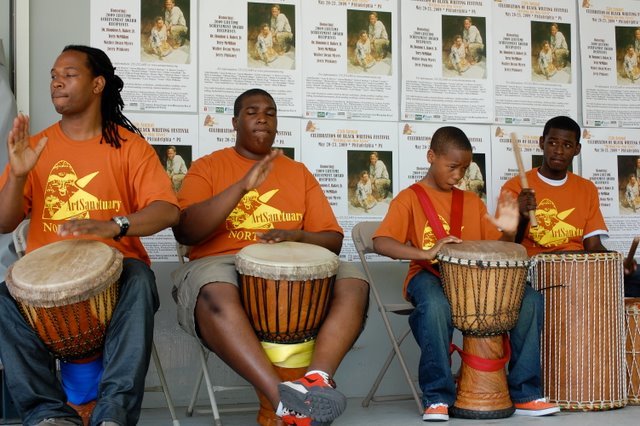by Ann de Forest
For a few sultry nights this past spring, North Philadelphia’s landmark Church of the Advocate was transformed into Harlem’s Cotton Club, circa 1940. On stage, teenage performers bedecked in vintage finery channeled stars of a bygone era – Ray Charles, Etta James, Billie Holiday. “This joint is jumpin’,” they sang, and by the end of an evening that interwove old-time jazz standards with hip-hop dance, African drumming, and spoken-word poetry, the audience was jumping too. The crowd was on its feet for the finale, clapping to a rousing version of Stevie Wonder’s empowering anthem, “Higher Ground.”
The North Stars Afterschool Program, in which 12- to 18-year olds study music, poetry, voice, and dance with accomplished professional artists free of charge, is just one of several high-impact programs initiated and run by Art Sanctuary, a community arts organization based at Church of the Advocate in North Philadelphia. As the brainchild of Philadelphia writer Lorene Cary, Art Sanctuary was originally founded to bring prominent African-American writers and performers to inner-city audiences all too often overlooked by national book and concert tours. At Art Sanctuary’s recent Reading in Concert series, for example, Pulitzer-prize winning playwright Charles Fuller spoke informally to an audience of high school students at Church of the Advocate about his craft, his career, and his formative years spent in the housing projects just a few blocks away.
“Art Sanctuary just doesn’t fit neatly into any box. That’s the thing that I think is terrific about them,” says Susan Seifert, director of Penn’s Social Impact of the Arts Project, which studies the links between cultural engagement and community wellbeing. From introducing a hip-hop curriculum in suburban schools to initiating a collaboration between North Stars and the Opera Company of Philadelphia to sponsoring an annual Celebration of Black Writing Festival, Art Sanctuary has impressed Seifert with the creativity of its programming and the breadth of its reach. “Art Sanctuary keeps bringing people together in different kinds of mixes, artistically and socially, and pretty much in every dimension. They’re a responsive learning organization,” she says with admiration. “This is the best of community arts.”
North Stars is just one example of Art Sanctuary’s responsiveness. The Afterschool Arts Program answered a need expressed by Eileen Brown, co-founder and president of Grands as Parents (G.A.P.), who was raising six grandchildren on her own. Also housed at Church of the Advocate, G.A.P. is a support group for grandparents and other relatives who suddenly find themselves caring for their children’s children. Although G.A.P. offered reading and crafts for younger children and sports activities for teens, Brown expressed concern that teenagers with more artistic inclinations did not have an outlet or a focus; Art Sanctuary established the North Stars program to provide that outlet. Since its beginning, more than 125 teens have been transformed by the program, including all six of Eileen Brown’s grandchildren, as well as many other G.A.P. youth. This year, Brown once again sat in the audience, proudly watching her two youngest grandchildren, Rasheeda and Tyann, perform in the African dance numbers.
While her granddaughters grin and glow after strutting on stage, Eileen Brown knows that North Stars’ true value comes from the program’s less glamorous moments. The gradual mastery of difficult dance steps and the steady presence of North Stars’ instructors, all accomplished artists in their own right, are what will make a lasting difference in the teens’ lives. “It builds up their self esteem,” she says. “They do better in school.”
Cary notes that shyer kids sometimes gain confidence at North Stars and then become so involved in student council or theatre at their schools, they no longer have time for the program. “Sometimes we’re victims of our own success,” she jokes. Susan Seifert’s research supports these observations. Social Impact of the Arts has demonstrated that neighborhoods with thriving community arts programs experience lower truancy and delinquency rates.
Church of the Advocate makes a fitting home for organizations like Art Sanctuary and G.A.P., which are part of a buzzing hive of community services at the church, including a soup kitchen and clothes cupboard based in the neo-Gothic National Historic Landmark. While its ample campus and cavernous interior support Art Sanctuary’s practical needs for storage, rehearsal and performance space, the church’s activist history is also a source of heady inspiration. As the site of the city’s Black Power Conference in 1968 and of the Episcopal Church’s first ordination of women in 1974, the Church of the Advocate resonates with the significant contributions it has made — not just to Philadelphia, but also to the world. As Cary says, “People get that we’re righteous if we’re at the Advocate.”
And though Art Sanctuary moved its offices to South Philadelphia this spring in order to further its commitment to build bridges to other neighborhoods and communities, the Advocate remains Art Sanctuary’s true home, where North Stars kids build confidence as they learn to play guitar and dance, and where renowned artists like Charles Fuller tell inner-city youth their own stories of struggle and triumph. “Our groundedness comes from our relationship with the church,” says Tarana Burke, Art Sanctuary’s managing director. “We will always be a part of the church.”

